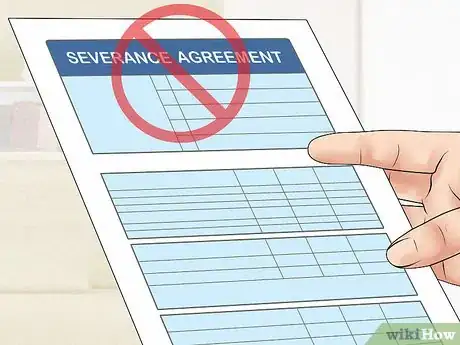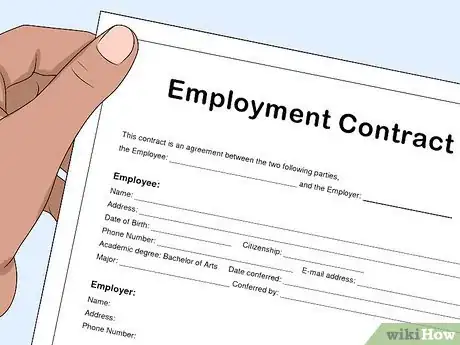This article was co-authored by Clinton M. Sandvick, JD, PhD. Clinton M. Sandvick worked as a civil litigator in California for over 7 years. He received his JD from the University of Wisconsin-Madison in 1998 and his PhD in American History from the University of Oregon in 2013.
There are 8 references cited in this article, which can be found at the bottom of the page.
This article has been viewed 181,226 times.
Severance pay is an amount of money that an employer agrees to pay an employee upon termination. Generally, an employer does not have to offer severance. However, if you have been terminated, then you should ask for it. Furthermore, if you are negotiating an employment contract, then you may want to get a severance package included in the contract.
Steps
Understanding Severance Pay
-
1Understand that severance is not required. Severance is generally not required by law.[1] [2] However, an employer could agree to include it as part of an employment contract. Alternately, the employer could offer severance at termination even if it was not included in the employment contract. Severance may be paid as a lump sum or in installments.
- Severance pay also is not “unemployment insurance.” Unemployment benefits are cash payments based on a percentage of your earnings. Each state sets a maximum amount.[3] The insurance is paid for by your employer.
- For tips on calculating your unemployment benefit, see Calculate Unemployment.
-
2Learn about a waiver and release. Some employers will offer severance to employees in order to limit their exposure to potential lawsuits. While offering severance pay is not itself evidence of an employer’s wrongdoing, some employers will nevertheless offer severance pay if they suspect an employee may sue the company. In order to get the severance pay, the employee must sign a waiver of all legal claims.
- These waivers release the employer from legal liability and are valid so long as the employee signed it voluntarily and knowingly.[4] Although you cannot be prevented from reporting discrimination to the Equal Employment Opportunity Commission, you can be prevented from bringing a private lawsuit.
Advertisement -
3Identify the parts of a severance package. A severance package can include much more than just a payment of money. Severance packages can also include:[5]
- Health and wellness benefits
- Positive letters of recommendation
- Uncontested unemployment compensation
- Moving expenses
- Ability to keep cell phone, computer, etc.
-
4Research if severance is common in your industry. If you are negotiating an employment contract, then you might want to know if severance is commonly included in employment contracts in your industry. Try to find examples of employment contracts or speak to an attorney who practices employment law and who specializes in your particular industry.
- To find an attorney, visit your state’s bar association, which should run a referral program.
Calculating Severance Pay
-
1Read your employment contract. If you have been laid off, then you should look at your employment contract to see if you are eligible for severance. If so, the contract should state how severance is calculated.
- Severance is most often calculated according to the length you have been with the company. For example, it is common for hourly-wage employees to be offered one week’s pay for each year that they have been with the company.[6]
- If you have worked for a company for five years, then you would get five weeks of pay at your current pay rate.
- Salaried employees sometimes are offered at least two weeks’ pay for each year that they have been at the company.[7]
- Accordingly, you would divide your yearly salary by 52 to get the weekly pay rate. Then, multiply this pay rate by the number of weeks. If you earn $39,000 a year, then you make $750 a week. If you worked for the company for 10 years, then you would get $7,500 in severance.
- Severance is most often calculated according to the length you have been with the company. For example, it is common for hourly-wage employees to be offered one week’s pay for each year that they have been with the company.[6]
-
2Ask if sick time and vacation time can be “cashed out.” You may not have an automatic right to “cash out” the value of any accrued sick time, vacation days, or personal time. In fact, few state laws require an employer to do so.[8] You should read your employment contract to see what rules govern cashing out this time. If you can’t find any rule, then ask your employer if you will be paid for this time.
-
3Negotiate for severance pay. If your contract does not have any clause pertaining to severance, then you can try to negotiate for it. You should think over any initial deal offered by your employer without immediately accepting it. If you are over 40, then federal law allows you 21 days to consider a severance package.[9]
- To counteroffer, you should come up with a reason why you need more money. Career coaches advise that you can mention the fact that you just bought a new house or have other recent, large expenses.[10] An employer may be sufficiently motivated to get you to sign a waiver and release that they will increase the amount of severance just to get you to sign.
- If you have an illness in the family, then ask for extended health benefits. You could get an additional six months before having to go on COBRA.[11]
References
- ↑ https://www.workplacefairness.org/severance-pay
- ↑ http://www.nolo.com/legal-encyclopedia/should-you-offer-severance-pay-29796.html
- ↑ http://www.careeronestop.org/reemployment/unemploymentbenefits/what-is-unemployment-insurance.aspx
- ↑ http://www.eeoc.gov/policy/docs/qanda_severance-agreements.html
- ↑ http://www.nolo.com/legal-encyclopedia/should-you-offer-severance-pay-29796.html
- ↑ https://www.severance-lawyers.com/typical-severance-pay-formulas/
- ↑ https://www.severance-lawyers.com/typical-severance-pay-formulas/
- ↑ https://www.workplacefairness.org/severance-pay
- ↑ http://www.forbes.com/sites/susanadams/2013/04/12/how-to-negotiate-severance-3/
About This Article
Severance pay is the amount of money that an employer agrees to pay an employee upon termination. While an employer doesn’t have to offer severance, you can ask for it if you’ve been let go. Or if you’re negotiating an employment contract, you may want to get a severance package included in your contract. A severance package can include much more than just payment of money. It can also include health and wellness benefits, positive letters of recommendation, moving expenses, or the ability to keep technology. If you’ve been let go, read your employment contract to see if you’re eligible for severance. If so, it’s often calculated according to the length you’ve been with the company. For example, often an hourly-wage employee will be offered 1 week of pay for each year that they’ve been with the company. To learn how to negotiate for severance, keep reading!



































































